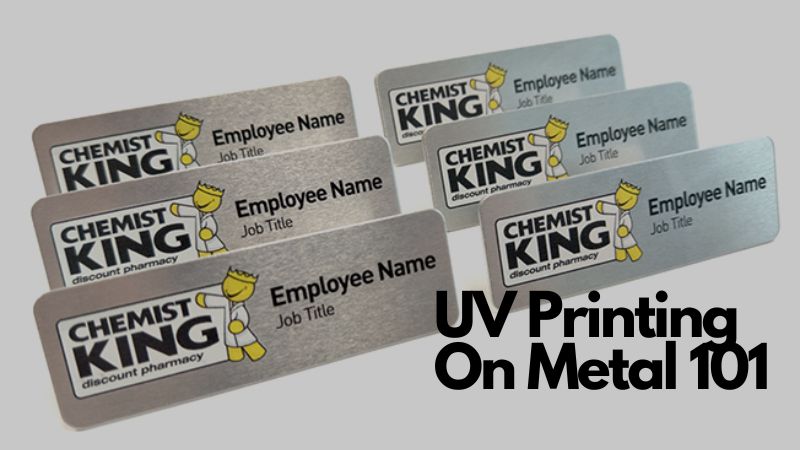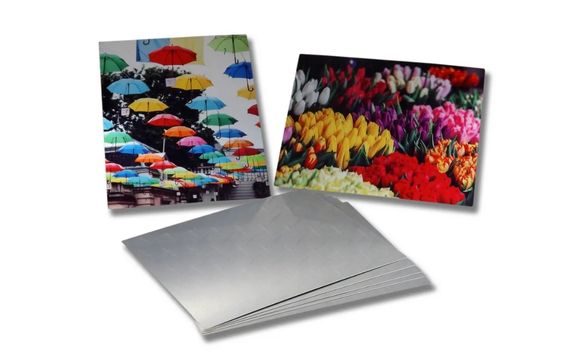
UV printing on metal is a new technology which has proved effective and reliable.
With the right settings, you can print metals, plastic, wood, leather or textile. However, for this guide’s scope, we will focus on UV printing on metals.
So, before starting your next UV printing on metal surface project, read this guide.
What is UV Printing?
Ultraviolet printing is a form of digital printing that uses UV to cure ink on the printed surface. It readily prints on various metals surface efficiently and faster.

Benefits of UV Printing
Today, UV printing on metal has become a perfect choice for most fabricators and designers. In fact, there are instances, it has replaced metal screen printing.
Here is why you should consider UV printing for metal projects:
- UV printing is cost-effective
- Metal UV printing is environmentally friendly
- Printing process is fast and saves time
- A flexible printing technique since you can print on many metal surfaces
- Guarantees high quality prints on metal surface
- Allows for full color enhancement
Limitation of UV Printed Metals
For UV-printed metals, these are some of its limitations;
- Initial investment cost is high
- Colors it can print are limited
- Ink requires UV to dry
- UV light may cause skin irritations
Despite all these challenges UV metal printing process remains a popular in today’s metal fabrication industry.
Step-by-step Metal UV-Printing Process
Usually, metal UV printing process is a simple process that involves the following steps;
Step 1: Get all Tools and Accessories Ready for the Printing Process
First, identify the type of material you would like to print on its surface. Remember, every material may require unique specifications. Take for example,
UV printing on stainless steel surface can be cumbersome without prior surface treatment. The surface will require special pretreatment.
For example, you can treat the stainless steel surface by:
- Flame treating the stainless steel surface – it will increase the surface energy there by facilitating UV ink adhesion on stainless steel surface.
- Wipe the surface using primer – a lint free towel with primer will work well for this surface treatment process.
Alternatively, you may choose aluminum material or any other metal surface. There are many UV printed aluminum products available today.
Remember, the coating on metal you wish to print will determine quality of the final product.
At the same time, you must choose high quality UV printer that can print patterns on metal surface. You must choose the right UV ink.
The UV printing machine should produce full color and durable prints.
Step 2: Design Pattern you with to Print
Whether you want to print graphics or letters, you must have proper design. You should ensure the dimensions are correct with suitable colors.
Also, ensure you save the file in the correct format, which can be interpreted or compatible with the UV printer. Moreover, ensure you are using the right software.
Step 3: Prepare the Metal Surface Ready for UV Printing
Remember, UV printers applies ink on the metal surface. Therefore, you should ensure the surface is free from any contaminants including dust particles, grease, etc.
In most cases, these contaminants may prevent UV ink curing process. At the same time, the prints quality will be low.
After cleaning, you will apply promoter on the metal surface. It doesn’t matter whether you want to print signage, hydro flasks, or machines parts.
Usually, the promoter will ensure UV ink bonds well on the metal surface. If possible, you can do a small test on the material. The test will help you establish whether the promoter and metal surface are compatible.
Step 4: Start UV Printing on Metal Surface
Once you have the design, UV printer machine and metal ready, it is time to start the printing process.
Before starting mass production, you should conduct a test print. It will help you verify whether the design is right and printer has been configured properly.
At this stage, you will determine the:
- Print quality
- Printing speed
- Check whether you have quality prints – you can make adjustments where necessary at this point
Once you are satisfied with the sample, now start the mass UV printing process. Even as you print, quality inspection and control must be a continuous process. You can check quality of UV printed metal section at different intervals.
Where possible, you can apply surface finish on UV printed parts. These may include special coating for:
- Better protection
- Chemical resistance
- Superior shinny finish
Best Metals for UV Printing
UV printing is a versatile technology you can use to print on many metal surfaces. For instance
UV printing on stainless steel and UV printing on aluminum are popular finishing processes in today sheet metal fabrication.
It is due to the high quality prints, or images. Also, the materials have better desirable properties for finished products such as durability, good surface finishing, etc.
Moreover, you can print other metals such as brass, copper, bronze and titanium surfaces, amongst others.
Applications of Metal UV Printing
Some of the applications of metal UV printing include;
- Branding – branding on metal using a metal UV printer helps advertise it.
- Warning signs – these are common, especially for places that are dangerous such as animal parks or dangerous roads.
- Artistic decor – artists can use metal UV printing to create beautiful artwork on a piece of metal.
- Barcoding – a metal UV printer allows one to barcode on a metal part.
- Labels – you can print on metal to give information about it.
- Machine parts – most machine parts are made from metal and with a metal UV printer you can print on the parts easily.
- Serializing – you can serialize any information on metal using this type of printer.
- Printing metallic packaging containers – the prints are durable and long lasting.
How UV Printing on Metal Sheets compares to Sublimation Printing on Metal
UV printing on metal sheets is a process that involves using ultraviolet light to dry ink or coating immediately after it hits the metal.
On the other hand, sublimation printing on metal involves dying the ink directly into the metal.
With sublimation printing, the letters and images may not be as crisp as UV printing on metal. UV printing on metal ensures the colors are exactly how they should be and are crisp.

Using a UV printer on metal ensures the print is long-lasting and remains colorful through the years. With the sublimation printer the colors fade with time and are not as durable.
For metals with a dark background, sublimation printing works best compared to UV printing. You are able to achieve the best printing quality with sublimation printing.
When you evaluate the printing speed, the UV metal printing is faster. UV printing is the fastest method of printing on metals and dries up equally fast.

UV printers use inks that are environmentally safe whereas with sublimation printers, their inks are not environmentally safe and can cause damage.
Screen Printing on Metal Vs UV Printing on Metal – How they Compare
Unlike UV printing, in screen printing metal, you will transfer a pattern you had stenciled to metal surface. During the process, you will require three main items to accomplish the process:
- Squeegee
- Ink
- Mesh screen
Screen printing is more versatile when it comes to printing on metals. You can print on several metals whereas UV printing limits you to a number of metals.
UV printing offers a wide range of color options which is not the case with screen printing. The colors from a UV printer are waterproof and very durable but those from screen printing are not waterproof and they fade easily.

Screen printing uses less ink compared to UV printing. This therefore means it is more affordable.
For an industry or company with a large demand you are better of screen printing because it has high printing speed compared to UV printing.
Best Inks for UV Printing on Metals
Inks best for UV printing include;
- Inks for Funai technology – this is best for metals with low maintenance needs.
- Water-based inks – this is best if you want metal with vibrant surfaces.
- Curable inks – this is the most durable and sustainable ink.
- Solvent-based inks – this ink is one of the best for metals because it attaches well to the surface.
Remember, even as you choose these inks, it should go hand in hand with metal surface pre-treatment technique. It will ensure optimal adhesion of the UV ink on the metal surface.
Additionally, the nature of material surface will determine the type of UV ink to use. For instance, there are special UV inks for:
- Hard and soft surfaces
- Flexible surfaces
- Hard surfaces
How To Choose UV Printing Machine for Your Metal Parts
For high quality patterns or designs on metal surfaces, you need high quality and reliable machine. It is a critical process during metal UV printing process. Among the key considerations include:
- Production or printing capacity
- Choose versatile printer with many color options
- Machine should be sustainable
- Low power consumption to reduce printing costs
- Machine cost
- Consider ease of maintenance and use
- Availability of accessories

Common Problems (And Solutions) in Metal UV Printing Process
When printing metal using UV printer, you may experience many challenges during the process. The best part, you can find perfect solution to most of these problems:
- Colour deviation – this is where the printed metal has a noticeable color deviation, which may be because of the wrong image format, its solution is setting the picture in the correct mode.
- Scattered ink dots on pictures – may be due to broken ink, resolve it by checking the ink point and correcting where necessary.
- Print drips – this means a nozzle dripped ink during the printing process. You should check for air leakage in the ink.
- Blurry picture – maybe because picture pixels are low. Increase the pixels to get good images.
- Horizontal lines on pictures – the cause may be poor printhead status, solve it by cleaning the nozzle.
Conclusion
UV printing may be known widely, but some people may not have heard about it. Many manufacturers use UUV printing because of its benefits and other advantages.
For anyone considering printing on metals, this is the best method.
More Resources:
Metal UV Printing – Source: P Craft
Stainless Steel Printing with UV – Source: IDS Digital
Applications for UV Printing (Marking Metals) – Source: Coldesi




